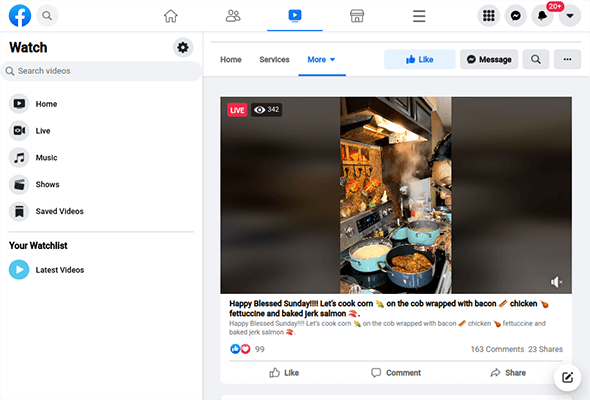How To Get More Likes On Facebook (7 Strategies That Work)
Do you want to learn how to get more likes on Facebook?
Maybe you want to improve your existing Facebook marketing strategy, or you need to plan your strategy from scratch.
In this post, we’re going to cover seven different methods you can use to improve your Facebook strategy. As a result, you will get more Facebook page likes.
And some of these tactics will work on other social networks.
Ready? Let’s get started:
How to get more likes on Facebook
The best way to determine how to get more likes on Facebook is to learn how users spend their time on the platform.
You can learn a lot from the following data collected by Cowen and Company:
- 65% view photos
- 46% watch videos
- 57% share content with everyone
- 43% share content with one person
- 38% read news
Specifically, it can help us develop seven methods to use to get more likes on Facebook:
- Create more Facebook videos – Facebook videos receive a lot of engagements, views and Facebook fans. While not a dedicated video hosting platform like YouTube, Facebook is one of the most popular sources for online video content.
- Broadcast to Facebook Live regularly – The social media platform is also a popular source for live streaming.
- Publish online quizzes to your site – Receive more likes on your Facebook page by enforcing likes in exchange for quiz results. This type of content is also incredibly shareable.
- Run a social media contest – Do a giveaway or a run a social media contest, and make liking your Facebook page a requirement for winning. Like quizzes, this content is highly shareable.
- Design better Facebook images – Images are a key source of content on Facebook, according to our aforementioned data. With the right image design, your post can receive a lot of likes and reach a wider audience that goes beyond your page’s followers.
- Include news in your Facebook feed – News is a primary use case for many Facebook users. Feed into this by becoming a top source of news in your niche.
- Create a Facebook group – Facebook groups receive huge numbers of engagement. Gain more likes by advertising your business through your own Facebook group.
Let’s elaborate on each one of these.
Method #1: Create more Facebook videos
Facebook videos are one of the most effective ways to receive more likes on individual posts and your Facebook page as a whole.
According to 99Firms, Facebook videos receive over 4 billion views every day.
Plus, video posts receive the highest number of engagements out of all post types you can create on the platform. According to data collected from over 34 million Facebook posts by Quintly, the makers of a powerful social media analytics tool, posts with links receive 72% fewer interactions than posts with videos. Posts with images receive 38% fewer interactions.
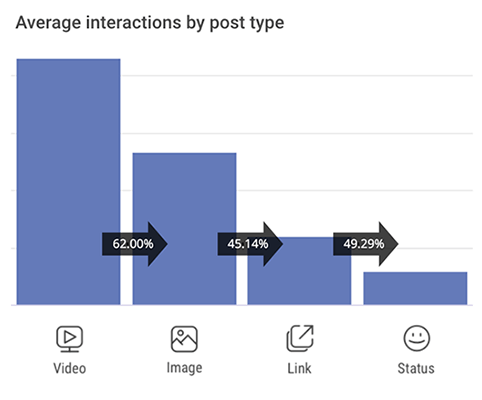
Quintly also found that Facebook groups with over 10 million fans dedicate 20% of their content to videos.
The conclusion to this data is simple: videos are an important element of Facebook’s platform. More importantly, you need to start focusing on them if you want to succeed on the platform.
So, how can you improve your Facebook video marketing strategy? You can include more videos in your social media marketing calendar, for starters. The data listed above clearly shows your best bet is to publish more videos than other forms of content on Facebook.
When it comes to creating videos, publish them in square format. Buffer conducted a study and found that square videos received more likes and interactions than those in other formats, including landscape.
Here’s an example from Bass Pro Shops featuring a customer-submitted video:
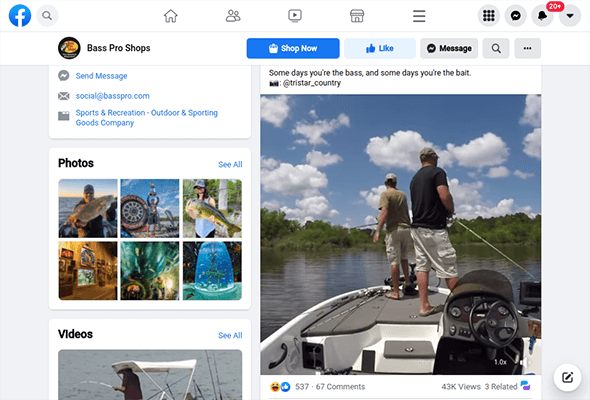
It’s a square video, so it fills up the video player without needing to insert black bars on either side, which users don’t seem to like.
You can also learn a lot by comparing this video to some of Bass Pro Shops’ other video content. This particular video is short and comedic. It features two men fishing on a boat until one man suddenly goes overboard.
Another popular type of video this page publishes are commercials for products they sell in their stores. However, these videos feature far fewer engagements, which means Facebook users would rather be entertained than sold to.
Does that mean your feed should never advertise products? Of course not. It just means you should focus more of your time on creating content that’s more likely to receive engagements.
Your videos will show up in people’s feeds more often this way. Eventually, you’ll have a larger amount of followers to advertise to when you do post video ads.
Another aspect to focus on is sound, including the lack of it. No matter what type of video you’re creating, audio quality will always be more important than video quality. If your budget is tight, be sure to spend more time and money on your audio production than video.
Furthermore, Digiday conducted a study of the Facebook page LittleThings, which garnered 150 million video views per month at the time. What they found was that 85% of those views occurred with the sound turned off.
If your videos contain a lot of speech, use subtitles. Currently, there are three ways to do this:
- Generate them automatically on Facebook and edit them.
- Add them yourself manually.
- Upload a SubRip (.srt) file.
You could also use the NowThis approach when it comes to creating videos. NowThis videos are popular across a variety of different platforms, including Facebook:
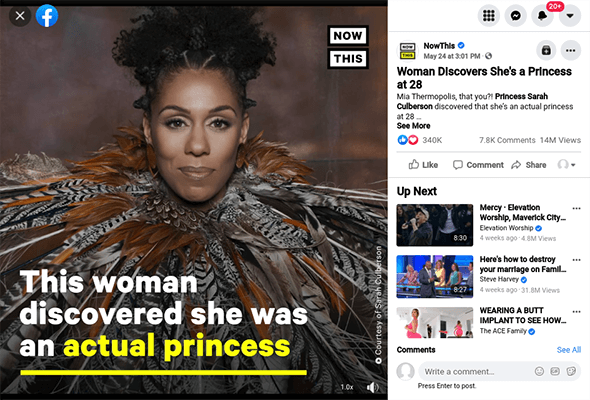
The company is known for publishing news-related videos. Their videos do contain some sound, such as interview questions being answered by the video’s subject in the example above.
However, they use captions to tell the rest of the story rather than an anchor as most media productions do.
Creators like NowThis rely on background music in place of an anchor’s voice for viewers who do prefer to listen to video audio. Use a stock music service like Storyblocks if you don’t have the means to produce your own music. This will reduce DMCA takedown notices.
Method #2: Broadcast to Facebook Live regularly
Livestreaming is a hot form of content that general internet users partake in every day but businesses, small-time bloggers and business especially, are slow to adopt.
Here are a few quick stats to prove why you should be hosting your own livestreams as well:
- Twitch, the web’s chosen livestreaming platform, hit a new milestone in late 2020 with over 1.6 billion hours watched in October of that year alone.
- Live videos hold viewers’ attention 10 to 20x longer than pre-recorded content.
- During the beginning of the COVID-19 lockdown (March to May 2020), viewership across Facebook and Twitch grew by 239 and 267% respectively.
- Out of the internet users who watch livestream regularly, 7 out of 10 watch them every day.
- 63% of people aged 18-34 watch livestreams regularly.
As for Facebook, the platform reached a new milestone of its own in Q1 of 2021 when it reached over 2.8 billion active monthly visitors. This makes the platform’s livestreaming capabilities much wider than Twitch’s as the latter platform has only 795 million+ active monthly visitors.
Plus, according to Facebook’s own insights of its platform, daily watch time for Facebook Live broadcasts grew 4x throughout 2020 and 1 in 5 videos is a live broadcast.
There are many different ways your business can use livestreams. Marion’s Amazing Catering, for instance, uses livestreams to showcase how she prepares her most popular dishes from start to finish.
This is a popular use case for livestreams: demonstrating how you in particular do something related to your niche in real time. This could be building a PC if your niche is all about computer-related topics, throwing pots if you’re in the pottery industry or installing a faucet if your niche tackles plumbing.
Here are a few additional use cases for livestreams:
- Weekly updates – Become a source of news in your niche by presenting a weekly live show where you and a co-host discuss the hottest topics of the week. You can also use this platform to provide updates on your business.
- Interviews – Use livestreams as a way to have conversations and interviews with influencers in your niche.
- Cover one-off topics – Shorter livestreams are a great way to engage your audience in conversations about specific topics or questions they have.
When it comes to broadcasting, you can either use a dedicated streaming system complete with an HD camera and high-quality microphone or simply use your phone and a compatible mic.
Again, just be sure your audio quality is clean, and find quiet places to broadcast from.
Method #3: Publish quizzes on your site
Online quizzes are an effective way to engage readers on your site. They’re fun and interactive, and they can even provide guidance when you use an online quiz maker that has conditional logic like Thrive Quiz Builder and Interact.
What these tools also have are multiple ways for you to receive engagements on social media.
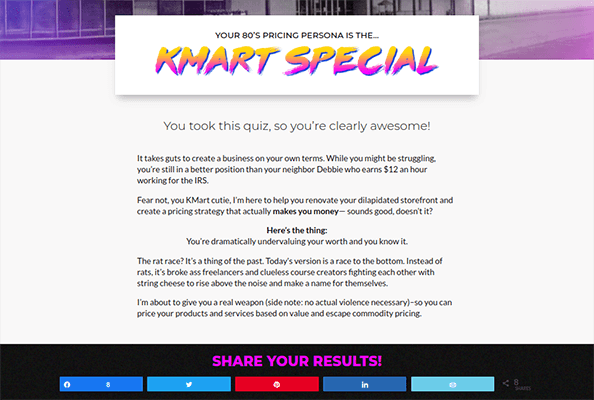
The simplest way to do this is to include share buttons on the results page. Some quiz makers even come with badges that make sharing results seem a little more fun for participants.
You can also lock quiz results and offer them in exchange for the participant’s email address, a like on Facebook or a share on at least one social media platform.
This is how you can use online quizzes to receive more likes on Facebook. The locking results in exchange for a like on Facebook method is self-explanatory.
Turning shares into likes isn’t as clean, but it’s still quite possible. When your quiz is shared on Facebook, your brand name and website are attached to it. Online quizzes become a great way to increase brand awareness, and more people look up your brand as a result.
Eventually, you’ll receive more likes on your Facebook page. Individual posts promoting the quiz on Facebook may also receive a lot of likes.
Method #4: Run a social media contest
A social media contest is another effective way to get more likes on Facebook. It’s a highly-engaging campaign to run depending on what kind of contest you go with and what you offer as a prize.
You have two options when it comes to the kind of social media contest you run:
- Giveaway – A non-competitive contest where contestants only need to input their information and follow simple requirements (like, comment, subscribe, etc.) to enter.
- Genuine contest – A competition in which contestants create or do something (drawing, photo, recipe, etc.) to enter.
If you choose the latter option, make sure whatever you have contestants do or create makes sense for your niche. Let’s use a computer blog as an example again. It’d make much more sense for this type of blog to have contestants enter pictures of their gaming rigs than it would to have them enter artwork.
Genuine contests are more engaging, but they’re more work. If you don’t have the time to look through and score entries, go with a simple giveaway.
Your prize should also make sense for your niche. If you don’t have a free product or discount of your own to give away, partner with a third-party company. Companies you’re already affiliated with or sponsored by are great options.
As far as running a social media contest goes, consider using a social media contest tool like Outgrow. Outgrow is primarily an online quiz maker, but it also has a giveaway feature.
This feature isn’t compatible with competitive contests, unfortunately. You’ll want to have contestants turn in their entries by posting to your page’s timeline instead.
The Facebook post you publish to promote your contest will receive a lot of likes. You can also require contestants to like and comment on the post to complete their entry.
Just don’t ask users to share this particular post on their own and friends’ timelines or tag their friends.
You can also use Outgrow to insert an entry form on your site and make one of the requirements to share the entry page on Facebook:
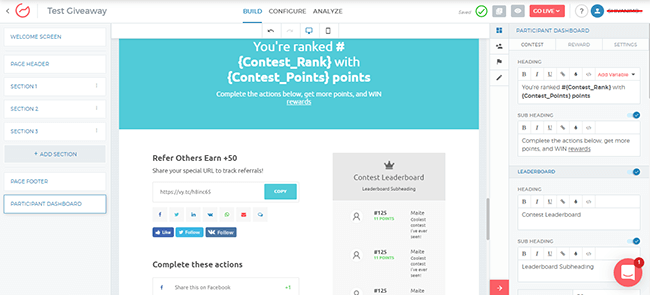
It’s a great way to draw a burst of attention toward your Facebook page and gain a lot of new likes as a result.
Method #5: Design better Facebook images
Calling back to the data we cited earlier, 65% of Facebook users use the social media platform to view photos.
You don’t need data to understand that users are mostly interested in viewing photos from friends and families and much less interested in viewing those from brands. Even so, you can truly get more likes on Facebook just by tweaking the way you design your images on the platform.
Facebook posts with text and links receive much fewer interactions than image and video-based posts. This means you’re much better off telling your stories and sharing your facts with images and videos than you are promoting these things with text.
Here are a handful of examples from Milkhouse Candles. Their competitors’ feeds are filled with stock images and simple product images against a white background:
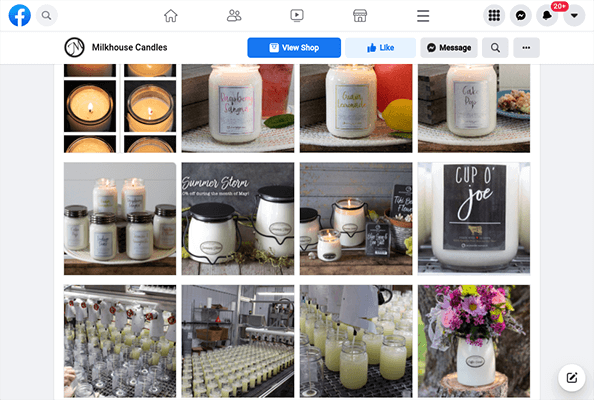
In their own photos, they take the time to set different scenes depending on the candle they’re photographing. They even have a few images of their factory floor, giving their customers a glimpse of how they operate behind the scenes.
If you have facts to share, create a simple infographic with Canva or Piktochart.
Here’s an example published by the NBA:
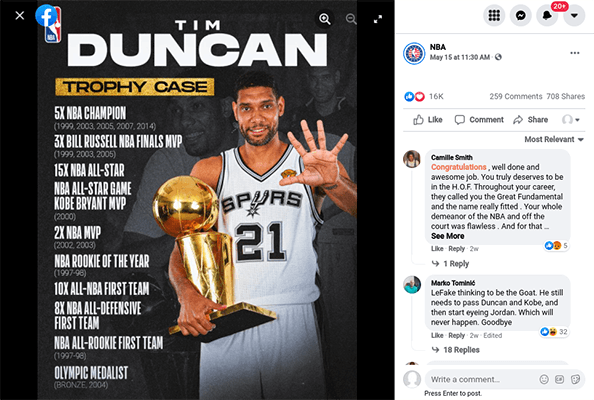
It’s a simple infographic showcasing which trophies Tim Duncan has earned and when he earned them. The post has garnered over 16,000 likes at the time this article was written.
Pinpoint popular topics, pain points and controversial opinions in your niche, and find ways to turn them into fact-based infographics to share with your audience on Facebook.
Method #6: Include news in your Facebook feed
According to our data, 38% of people use Facebook to read news.
This doesn’t mean you should become a news aggregator. In fact, the data we listed throughout this post demonstrates why that’d be a terrible way to get more likes on Facebook (posts with links receive over 70% fewer interactions).
You should combine your objective of including more news in your feed with some of the other content methods we listed in this article instead.
We already went over one when we talked about livestreams. Engage your audience with a weekly livestream in which you (and a co-host, if you wish) cover the week’s hottest topics and current events in relation to your niche.
These types of topics could also be the subjects of videos you publish on your Facebook page. Follow NowThis’ lead and create 15 second to 2-minute videos featuring mostly text and appropriate background music.
Lastly, you can use infographics and simple graphics to showcase facts and headlines about the latest news stories in your niche.
Here’s an example from gaming media company IGN’s Facebook page. It’s an incredibly simple yet quite effective graphic. It features a headline about a highly-anticipated product in the company’s niche:
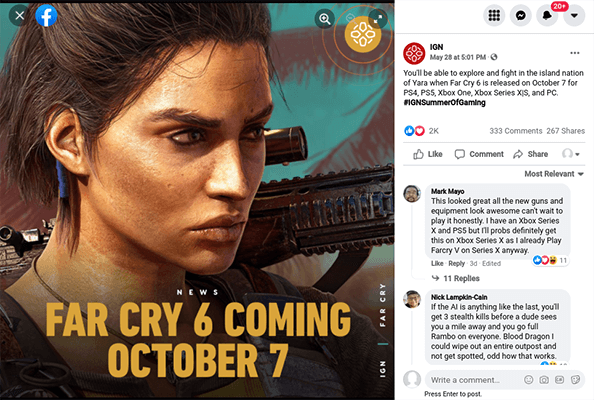
Method #7: Create a Facebook group
Facebook groups are clubs you can join on the social media platform. They can be for a variety of different purposes, such as creating a group to discuss your favorite show, a group to connect with people who struggle with the same illness as you or even a group filled with people who went to your high school.
Here are a few quick facts on Facebook groups, including a callback to a fact we shared earlier:
- Over 10 million Facebook groups exist.
- Over 1.4 billion people use Facebook groups every month.
- Many Facebook groups that dedicate 20% of their content to videos have over 10 million fans.
You can create a group and post in it as your page. It’s a great way to engage your audience even further and expose your brand to more people, making Facebook groups another great way to receive more likes on Facebook.
When you’re coming up with a focus topic for your group, come up with ideas that are helpful or entertaining. If you own a pottery blog, create a group where your audience can receive tips on issues they’re having with their own projects. If you’re in the book industry, use a Facebook group to create a book club for your audience.
You essentially want to turn your audience into a community by targeting topics they care deeply about.
How to improve your Facebook marketing strategy
The methods listed above are more than enough to help you turn your Facebook page into a viable marketing machine.
However, there’s still a lot you can do to improve your Facebook marketing strategy overall:
- Post to Facebook several times a day – Quality must always take priority over quanity. However, Facebook users check the social media platform 14 times a day, so feel free to post however often you like so long as each post is as impactful as the last.
- Create better Facebook ads – The data in our Facebook statistics article proves that Facebook users love to click ads. Use Canva to create better ads, and experiment with different designs. You should also consider using videos.
- Prioritize Facebook Messenger – Facebook Messenger is the second most popular messaging app in the world. Staying connected with your customers is one of the simplest ways to establish trust and understanding. It also allows customers to contact you in a way that may be more comfortable for them. And it can be used together with chatbots to automate your marketing.
- Recycle old, proven content – If you’re having trouble coming up with content for your Facebook page, go through your blog and older social media posts. Find what’s worked in the past and determine how you can turn that content into a video or image.
- Use a social media marketing tool – Social media automation tools like SocialBee make it possible for you to plan your social media calendar ahead of time so you don’t need to waste time publishing content to your accounts manually. This particular tool also has a feature that enables you to keep your queue filled with evergreen content.
- Target older age demographics – The fastest-growing demographic on Facebook is the 65 and older crowd. Usage stats fall among the younger age demographics. In fact, 51% of teens do not use Facebook. This means you’re much better off targeting your marketing messages toward older demographics (30 and up) that likely have full-time jobs and children.
These extra tactics will allow you to optimize nearly every step of the Facebook marketing process.
Final thoughts
The advice we’ve shared in this article will help you get more Facebook likes, and develop a strategy that generates traffic & revenue for your business.
Now, Facebook may be one of the most popular social networks around but it isn’t right for every business. So, you may want to check out these Facebook statistics before committing to it.
Related Reading:
- 13 Best Social Media Scheduling Tools: Tried & Tested
- How To Create A Social Media Strategy: The Complete Beginner’s Guide
- 42 Top Social Media Statistics For 2023: Usage, Demographics, Trends
Disclosure: If you buy through links on our site, we may make a commission. This helps to support the running of Startup Bonsai.

